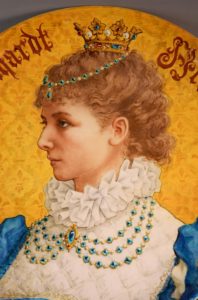ERNEST CARRIERE
Signed “TH Deck” and profile stamp on the back
Material : Glazed ceramic
Provenance : France, circa 1887 – 1899
Dimensions : D : 29,5 cm
Ceramic plate with a mallard on a blue background attributed to E. Carrière
Our plate presents a realistic duck with its wings spread out and its head bent on blue background copying the sky and water. These two elements are distinguished themselves remarkably thanks to their realization. For the water, the artist has created a move with horizontal lines, while for the sky it’s more a concentric move going toward the plate edges. The white and blue tons depending on the enamel density bring an extra touch of realism in the sky as in the water.
The mallard is typical of the decors made by Ernest Carrière (1858 – 1908) in the 1890’s – 1900’s.
Ernest Carrière was a student at the École Nationale des arts décoratifs in Paris before finishing his apprenticeship with his brother the painter Eugène Carrière (1849 – 1906) to whom he is quickly compared to. He becomes one of the principals Deck’s co-painter from 1887 until the end of the 1890’s. His decors on ceramic are mainly birds and are named Savage ducks’ fly, Golden pheasant or even Swallow of the seas. His birds are depicting with a very high precision and an extreme clearness thanks to his enamels mastery as our plate shows.
EDMOND LACHENAL
Plate depicting the portrait of Sarah Bernhardt in Doña Sol
Ce grand plat en céramique polychrome présente un portrait de profil de l’actrice Sarah Bernhardt dans son rôle de Doña Sol dans Hernani. Il a été réalisé par le céramiste Théodore Deck (1823 – 1991) et peint par Edmond Lachenal (1853-1948) en 1878. Les inscriptions en lettres médiévales « Sarah Bernhardt », « Hernani 1878 » ainsi que la signature du peintre y sont visibles entourant le portrait. Il s’agit du seul exemplaire connu à ce jour.
Signed «TH. Deck» under the base
Material : Glazed ceramic
Provenance : France, circa 1870 – 1880
Dimensions : D : 40 cm
Plate with a decor attributed to E. Lachenal with flowers and butterflies on a purple background
The decor of this plate composed of flowers and butterflies is attributed to the artist Edmond Lachenal (1855-1948) who works at the factory as a student and then as a workshop chief between 1875 and 1881 before opening his own. A plate with a similar decor also on a purple background and bearing the signature “E.L.” on the decor is today kept in the Metropolitan Museum of Art in New York. The stylistics similarities allow us to attribute the decor of our plate to the same artist.
Plate decorated with petunias and a butterfly
Lot of petunia flowers on a leafy branch are standing out again a purple background. They are accompanied by a lonely butterfly, symbol of happiness and immorality in the Japanese culture. The artiste enchants us by the dazzling colors he chose for this plate’s decoration and that he succeeds to make harmonious. Flowers are painted in yellow, orange and white. While some of the leave are green, others are painted with the famous artist’s turquoise blue and remind of the butterfly’s wings.
Signed «TH. Deck» on the back
Matériau : Glazed ceramic
Provenance : France, circa 1875 – 1881
Dimensions : D : 29,5 cm
Plate with a decor attributed to E. Lachenal with a poppy flower
Our plate shows a poppy flower which appears very often on Deck’s patterns, on a purple background. The poppy flower is colored in pale yellow with a leafy stem colored with the artist’s famous turquoise blue. On the background we can also see branches with small leaves colored in ochre reminding the Japanese gardens.














